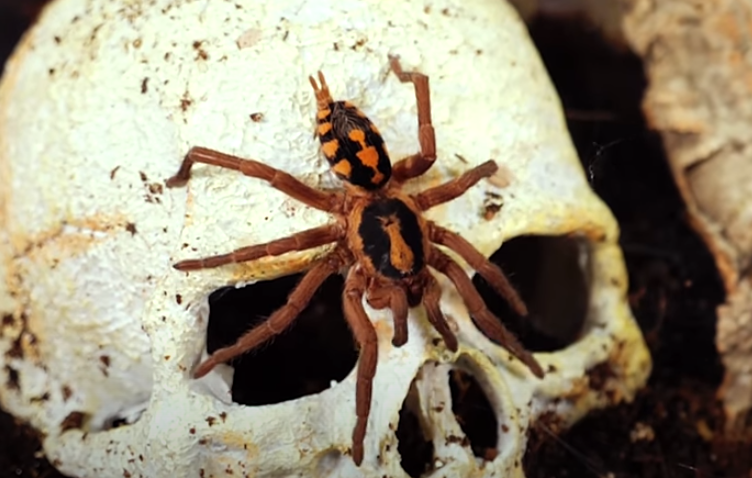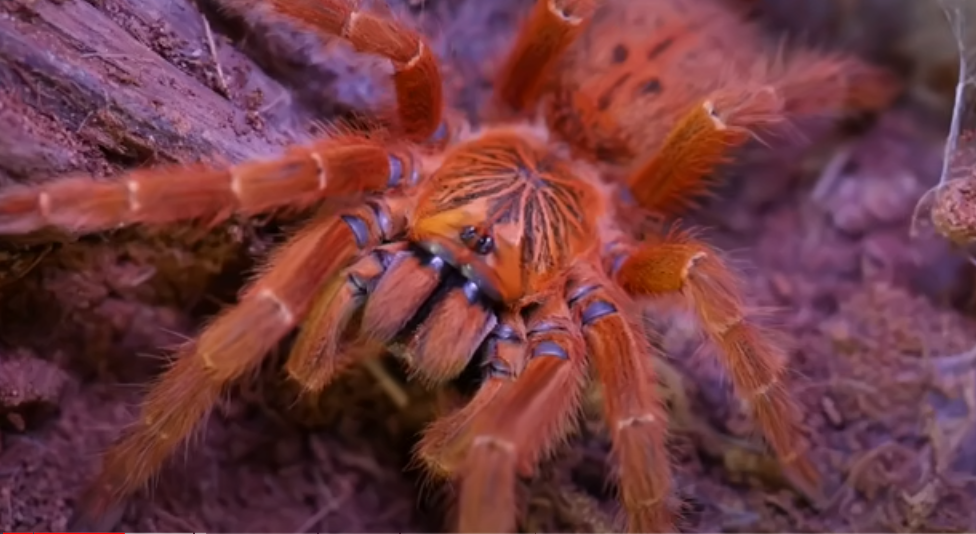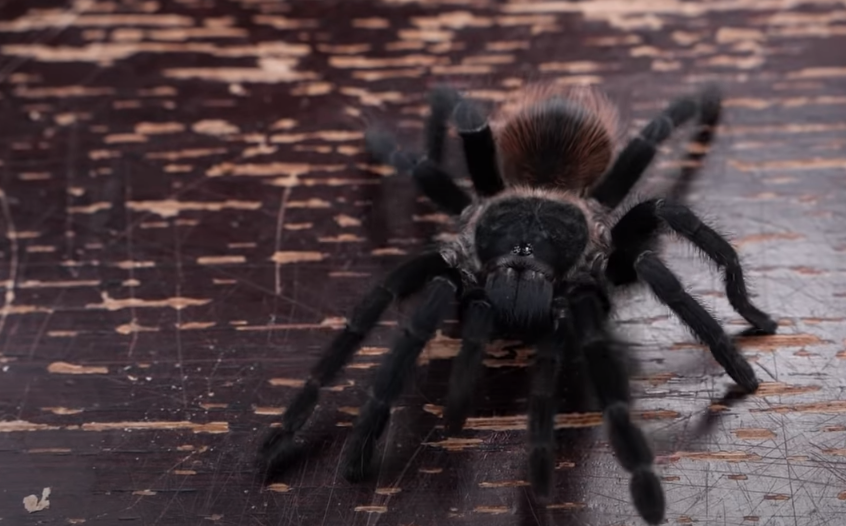As you know that, Tarantulas are the enormous spiders in the whole world. They are incredibly skilled spiders competent in conquering just about any living being, even those larger than themselves. In Africa, they are known as hairy spiders. Many tarantulas live in Central American jungles and are known as Baboon spiders. But some have their homes in California and North America.
Table of Contents
ToggleThere are a lot of tarantula species. Theraphosidae are distinct by their hair and big size. Most of them have black or brown color, and they are 7 to 10 centimeters in length.
They have colorful stripes and patterns on their bodies, such as some famous Theraphosidae species, including Red-Knee, a red-rump, and cobalt Blue tarantula with beautiful skins. The tarantulas have many colors and sizes that are popular in the foreign pet markets.

| Scientific name | Theraphosidae |
| Class | Arachnida (Arachnids) |
| Family | Theraphosidae |
| Order | Araneae |
| Suborder | Mygalomorphae |
| Species | About 900 |
| Genera | Minimum 123 described |
Physical appearance
Similar to all other spiders, there are two body segments of tarantulas. One is cephalothoraxes, and the other is in the abdomen. They have powerful jaws with venomous fangs. They have eight legs and a layer of tiny hairs on them. Several tarantulas exercise their legs to brush fine hairs when troubled. These are called urticating hairs. They have two pedipalps that are used for moving victims.
Theraphosidae also has fangs from where they discharge venom when searching for food and hunting. Their fangs are more prominent as they have a significant physical appearance. Similar to other spiders, tarantulas have eight eyes that match together. Generally, the large two eyes are in the middle of their head, and three eyes bound these on either part. It is observed that the female tarantula has a more solid body that is covered with light brown hair. And the male Theraphosidae is thinner, covered with black hair, and some have reddish fur on their abdomen.
Life Span
Male tarantulas survive 10 to 12 years. Females can live 25 years.
Size
The most considerable tarantula leg length is 11 inches (28 centimeters), male Goliath bird-eating spider (Theraphosa blondi). Smaller spider leg length is 4.5 inches (11 centimeters), males in (genus Avicularia).
Weight
The weight for a small male is 28 grams in genus Avicularia and for a large female is more than 100 grams.

Habitat of Tarantula
Theraphosidae live in dry and warm areas such as deserts, scrubland, and grassland areas. They are found in all continents except Antarctica. Their favorite habitats are rainforests and well-drained soils in open spaces. The tarantula digs a deep hole and positions it with soft silk webbing if the ground is appropriate. The web is used to assist in managing foodstuff and to make a home. Some species are lived in trees, cliffs, caves, rocks, logs, and in crops like pineapples and bananas. These giant spiders are introverted creatures so that in one house, there is only one spider.
Diet
Tarantulas are carnivores and eat meat. They are nighttime hunters and eat many kinds of insects like tiny spiders, snakes, mini lizards, grasshoppers, cicadas, and caterpillars. Tarantulas have fangs that discharge venom that kills their prey, and a chemical in the poison dissolves the prey’s flesh. Tarantulas use their strong mouthparts to crush their victim. The giant tarantula also eats toads, fish, bats, and millipedes. A type of tarantula named Goliath Bird eater diet is small birds. Many people are frightened of tarantula bites, but the reality is that their venom potency is comparable with a bee.
Wild status
Several tarantula species are in danger of extinction. The over-collection of pet trades and habitat destruction is a significant cause of this threat. But some common kinds are not threatened.
Predator
Lizards, spider-eating birds, foxes, snakes, and coyotes are the predators of tarantulas.
Home
The desert tarantula makes their homes in deep holes covered with silken webbing to avoid its caving in. With the growth of the spider, the burrow also grows. Some Theraphosidae may hide in logs and cracks if the soil is not suitable for them.
Family Life of Tarantula
An adult tarantula abandoned his burrow to look for a female by following her smell. They mate if the male is appropriate for her. The male tarantula spread sperm on the web, and the female makes a cocoon for her eggs in her home. She seals the cocoon with silk when she lays eggs and then makes a protection layer for 6 to 9 weeks in anticipation of the immature hatch. The female may eat male if he attaches to the web for a long time.
In some cases, after mating, some males usually die after a few months, but females produce eggs and live for almost 25 years or more. The wild Theraphosidae may live 30 years. The female tarantula has a longer lifespan than the male tarantula.
During each growth spurt, all tarantulas must shed a hard exoskeleton. With its spinnerets, the tarantula produces a soft carpet and turns over onto its back. The tarantula must force it off by stretching and compressing its body while the old exoskeleton opens on the rear. The spider turns back over after the procedure is finished and the new exoskeleton has had time to solidify. The shed frequently appears to be another spider at first glance! As they get older, young tarantulas molt numerous times throughout their first few years.
CONSERVATION
CITES protects and collects tarantulas for the pet trade. The shelter for a large group of tarantulas is Zoo confiscated by the U.S. Fish and Wildlife Service. They also protect tarantula from an illegal smuggling nip. Many spiders are kept as pets in South Africa. It is not recognized which species are most popular, which are more dangerous, which are traded and whether people use their names correctly or not.
Even if spiders are terrifying predators, others frequently eat them. There are a lot of natural enemies of Theraphosidae, such as Lizards, spider-eating birds, wasps, and even snakes. A giant female tarantula can search a tarantula, nip it, and then pull its bewildered body to a hole that she prepares. She lays a single egg on the body of the spider inside the hole. It eats the tarantula when a young insect hatches.
Tarantula Care Sheet
To keep a tarantula as a pet can be an attractive hobby. It is exciting to watch and takes up relatively little space and is easy to maintain. But it is suggested that tarantulas are not the best pets s they have venoms. One more concern is the skin rashes from the hairs on their abdomens. In case if the hairs enter your eyes, they can cause severe swelling. Moreover, keep away the children and other pets to the reach of a Theraphosidae.
For housing, there should be a secure cage because tarantula is not a social animal. Although tarantulas are escape artists, the lid must have ventilation.
Theraphosidae should be kept in 5 to 10 gallons of the terrarium with a top screened. At the bottom of the terrarium, there should be a clean substrate. The depth of the terrarium will differ based on the kinds. A location must be provided where the tarantula can hide. There should also be a heat source and a heating pad under the terrarium. There should be food like mealworms, super worms, crickets, and other insects. Clean the place as needed and remove the rotten food daily. It is suggested that to deep clean the whole enclosure every four months. They should supply a small dish of clean water all the time. For more information visit here Care Sheet.
Facts about Tarantula
- They are hairy spiders, and there are approximately 900 species in the world.
- Many people in South Africa eat tarantula after roasting them.
- The enormous spider on the earth is Goliath bird-eating.
- They are terrifying creatures, and most of them have venoms, but some are relatively passive.
- Some impose deadly bites with venomous fangs, like Goliath bird-eating tarantula.
- Some tarantula’s have attractive blue shades.
- They have jaws that move up and down, rather than the general side-to-side movement in other spiders. They have eight mini eyes used to differentiate the slightest motion, hairs on their body that are sensitive to vibrations.
- Most spiders rely on their venom to dissolve their victim because they have no teeth to grind their food. Then they suck up the meal by using their sucking stomachs.
- A giant spider wasp finds tarantulas and attempt to sting them. The sting paralyzes the spider. The wasp will lay eggs on the paralyzed body of the spider and seal it up in the burrow. The spider becomes the fresh meal for the wasp after hatching.
- In the desert areas of south-western Mexico, when there are rainstorms, many male spiders warder around to find females for mating. In some species, the male performs courtship dance to attract the female to become approachable.
- Some species have gum’ hairbrushes on their legs which help them to climb vertically up even the smoothest foliage.
- Tree-residence species put a mate by their smell and then follow the silken track that the female leaves as she moves.
Also read about:
Accessories for Tarantula’s Enclosure
Choose the Best Enclosure for your Tarantula
How log do jumping spiders live?
Do wolf spiders climb into beds?
Are tarantulas dangerous to a human?
Theraphosidae are generally typecast as hazardous, a myth often reinforced by movies and TV. Hollywood is directly to blame for these spiders poisonous to human’s reputation. They are big, easily handled, and some have attractive colors which are photogenic; and therefore, they have been broadly used in adventurous and horror movies. When some “poisonous” creature is required to menace James Bond or Indiana Jones, attack a miniature town in huge numbers, or produce to enormous size and stalk the Arizona desert for the human victim, the special-effects team takes out the tarantulas!
Their large bodies and fangs make them scary like monsters, but most tarantulas are not dangerous to humans in the real world, particularly new World species. Like most spiders, tarantulas rarely bite humans and will almost always run away if they choose. A bite from a tarantula is identical to a bee sting, with only temporary hurt and swelling. Some are kept as pets in many areas. In Africa and Asia, some tarantula bites have been reported to cause mild sickness, but there have been no reported human deaths due to poison from a tarantula bite. The venom itself may not be poisonous to humans, but it may cause some irritation and allergic reaction in humans. The new world tarantula’s hair may irritate eyes and nose and skin rashes. So it is suggested that to keep your face away from them.
Does tarantula bite?
The clear and short answer is: yes, Theraphosidae bite humans. When they are searching for victims, they bite to insert venom into the victim’s body. The toxin paralyzes it, and then they can get food by injecting digestive enzymes.
They have a fearsome reputation, but most bite insects like grasshoppers or cricket but not a person. The enormous tarantula is even smaller than human size, and they somewhat run away and brush their hairs at potential predators than bite them. They might bite humans as they have enormous fangs, and the bite itself might injure. Sometimes they give a dry acidity to damage and run away but do not inject venom. And their edge, for some people, is like a bee sting which is a little painful. The bite might have an allergic reaction and swelling on the face so that if the edge hurts someone, they need medical attention.
There are some symptoms of a bite. If a tarantula bites you, you may feel pain on the spot of the edge. The pain may be light as a bee sting. The area of the bite may become red and warm. If the spider feels threatened, it rubs its legs with its body and flicks thousands of tiny hairs towards the danger. That hair can cut human skin and cause swelling and itchy bumps.
To read about
Pumpkin Patch Tarantula visit here. Orange Baboon Tarantula visit here. Brazilian Blue Tarantula visit here.







One Response
MashaAllah Superbly Amazing.
It is a first step for you to win even greater laurels in future life.
In sha Allah you gonna rock this stage called world ❤️